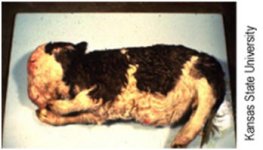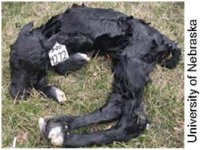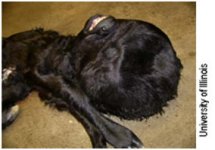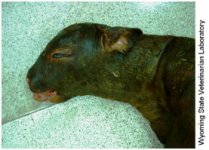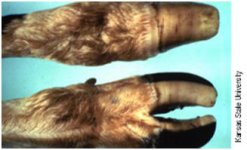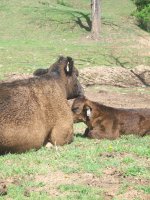Here's another article with a few more details. Note this is trying to get information out so as many breeders as possible will make informed breeding decisions. In the event carriers are used it is would hopefully be to obtain free descendants of the carrier. I know a breeder who flushed to a well known carrier in hopes of getting a TH free son. It all comes down to knowing the risks and being responsible. Many ways of going about it but knowledge is key. JMO.
http://beefmagazine.com/genetics/avoiding_worst_20100201/
Avoiding THE WORST
Feb 1, 2010 12:00 PM, BY JOE ROYBAL, EDITOR & WES ISHMAEL, CONTRIBUTING EDITOR
Modern technology and good old-fashioned management minimize the challenge of genetic abnormalities caused by recessive genes.
Share
The science and application of genetics has allowed animal breeders to make tremendous strides in production efficiency. Coupled with modern nutrition and management, U.S. beef producers today produce a beef tonnage equivalent to that of 30 years ago — but with 25 million fewer head of cattle.
There's no doubt that the industry's ability to identify outlier animals that defy genetic antagonisms and excel for a variety of traits has been a boon to the industry.
One downside, though, since true genetic curve benders are so few and far between, is that their magnified use can become a problem if it turns out they also drag some unwanted genetic baggage with them.
That's what rocked the beef industry a year ago when Arthrogryposis Multiplex (AM), a lethal genetic defect, was discovered in one of the Angus breed's most used and coveted bloodlines — GAR Precision 1680.
According to Precision 1680's performance record from the American Angus Association (AAA), nearly 10,000 direct sons and daughters are part of the breed's genetic evaluation. He was one of the first Angus sires to bend the curve and provide low birth weight but superior weaning and yearling growth.
Every breed, species and individual contains recessive genes that are seldom expressed and thus rarely known about. In the case of Precision 1680, inadvertent propagation was the catalyst. His genes were being multiplied and magnified because of his genetic merit, but no one knew he also carried the recessive gene for AM.
Also known as Curly Calf Syndrome, AM results in stillborn calves with bent and twisted spines.
Science offers options
In the old days of genetic defects like Snorter Dwarfsm, such a discovery would have been the death knell for an entire line of cattle and a major blow to the breed itself. In those days, the only way to manage such defects was to avoid them, period.
Many are familiar with coat color in Angus as an example of how the simple mode of genetic inheritance works; red is recessive and black is dominant. If a calf receives the gene for black from one or both parents, its coat color will be black. In order for the animal to be red, it must inherit the recessive gene (red), from both parents.
Though genetic defects inherited in this manner create challenges, especially for seedstock producers, new technology means these simple recessive genetic defects — which AM appears to be — can be managed without throwing away the bloodline.
In the case of AM, a genomic test that screens for the presence of the defective gene also means seedstock producers can still utilize the bloodline while avoiding the problem.
For commercial producers, the odds of mating a carrier bull to cows that are also carriers are extremely low.
Managing genetic defects
AAA breed officials took a proactive approach to AM. Rather than insist on testing and printing results for full disclosure, then letting breeders and the marketplace assign values, AAA moved to eliminate the problem more quickly by banning the registration of carrier animals in the future. For more on this issue, see “Dealing With Curly Calf” at
http://beefmagazine.com/genetics/1201-curly-calf-issue/.
This model offers direction to other breeds that possess other genetic defects.
There are 21 genetic abnormalities under management by beef breed associations — conditions ranging from fawn calf syndrome to hypotrichosis to dwarfism in its various forms (see Table 1).
“For commercial producers, the trick to avoiding calves with lethal or performance-threatening abnormalities is never to mate a carrier bull to a carrier female,” Kent Andersen, then the executive vice president of the North American Limousin Foundation, said last spring. “The first and easiest line of defense is to use only bulls free of the relevant defect in a given population.
“Mutations that cause abnormalities always will be a reality of the livestock business,” he says. “Fortunately, with advances in genomics technology and thoughtful management by associations and breeders, we can mitigate the adverse effects substantially.”
Four options
During the 2009 Beef Improvement Federation meeting in Sacramento, CA last spring, Jonathon Beever, University of Illinois in Urbana-Champaign geneticist and one of the nation's top authorities on genetic defects in cattle, told producers of four options in dealing with a potential genetic defect carrier in a cowherd population. He said producers could:
•Ignore the issue and risk future problems.
•Completely eliminate the genetic source, which would be contrary to overall breed improvement
•Find outcross genetics to breed away from the gene pool with the defect. While this isn't a practical option for seedstock breeders, it would be for commercial operations, particularly if they produce a terminal cross.
•Accurately identify the carriers through genetic testing, and then manage the problem.
Beever called the latter point the most responsible choice, given the high accuracy and growing cost-effectiveness of genetic testing. Beever adds that how producers develop their response within the beef industry will also be influenced by their place in the production system, with seedstock breeders being particularly proactive. (See “The Lowdown On Genetic Defects” on page 24.)
About this table
This listing of genetic defects is exclusive and limited to diseases that are still of concern, reflecting genes that are still present in beef cattle populations, or were in the last 5-10 years. Specific breed listings may seem over-represented because of recent genetic discoveries and proactive steps in management.
It is imperative to understand the inheritance pattern regarding genetic defects. In a simple recessive mode of inheritance, it takes a Carrier x Carrier mating to have a calf with a genetic defect. Even in that mating, the resulting offspring will have a genetic defect 25% of the time.
— Alaina Mousel
Table 1. Genetic abnormalities under management by beef breed associations Genetic abnormality Primary breed(s) of incidence Lethal or nonlethal Mode of inheritance DNA test available? Management stage
Arthrogryposis Multiplex (AM, or “Curly Calf Syndrome”) Angus & derivatives Lethal Simple recessive Yes DNA testing underway
Beta (β)-Mannosidosis Salers Lethal Simple recessive Yes Effectively eradicated
Fawn Calf Syndrome (FCS) Angus & derivatives Nonlethal Simple recessive No Under investigation
Neuropathic hydrocephalus (NH) Angus & derivatives Lethal Simple recessive Yes DNA testing underway
Hypotrichosis (hairless calf) Hereford Nonlethal Simple recessive Yes DNA testing underway
Idiopathic epilepsy (IE) Hereford Nonlethal1 Simple recessive Yes DNA testing underway
Osteopetrosis (marble-bone disease) Angus & Red Angus derivatives Lethal Simple recessive Yes DNA testing underway2
Protoporphyria Limousin Nonlethal Simple recessive Yes Effectively eradicated
Pulmonary hypoplasia & anasarca (PHA) Maine-Anjou, Shorthorn & Dexter Lethal Simple recessive Yes DNA testing underway
Tibial hemimelia (TH) Shorthorn & derivatives Lethal Simple recessive Yes DNA testing underway
Double Muscling Multiple breeds Nonlethal Simple recessive Yes DNA testing underway
Syndactyly (Mule Foot) Angus, Simmental, Holstein Nonlethal Simple recessive No Under investigation
Dwarfism (snorter) Angus Nonlethal Simple recessive Yes
Dwarfism (bulldog) Multiple breeds (non Dexter) Lethal Simple recessive No Under investigation
Dwarfism (bulldog) Dexter Lethal Simple recessive Yes DNA testing underway
Dwarfism (long headed) Angus Nonlethal Simple recessive Yes DNA testing underway
Heterochromia Irides (white eye) Angus Nonlethal Simple recessive No Carriers identified by affected offspring
Red color gene Multiple breeds C Simple recessive Yes Routine testing
Wild-type color gene Multiple breeds Nonlethal Variable Yes Routine testing
Dilution of coat color Hereford, Simmental, Gelbvieh Nonlethal Dominant Yes DNA testing underway
Alpha (α)-Mannosidosis Angus, Red Angus, Murray Grey, Gallaway Lethal Simple recessive Yes Test available
1The American Hereford Association lists Idiopathic epilepsy (IE) as a lethal genetic defect;
2A DNA test for Osteopetrosis is not available for Angus cattle, but the test available for Red Angus may work for Black Angus
Source: North American Limousin Foundation, Dr. David Steffan, Dr. Jon Beever
Vingnette

